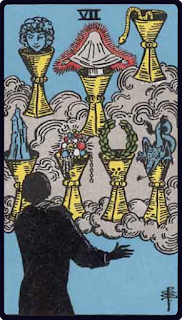
Representing reinvention; the 7 of Cups represents the possibility of forward movement and the myriad of directions that we could take. This card as it pertains to relationships represents the unity, agreement, and act of living together, not in the sense of cohabitation in the literal sense but rather in terms of living your life and sharing that experience with another. Where this direction was depicted within the 6 of Cups as the result of conflict, ultimately influenced by it, the 7 of Cups in turn represents direction with clarity. The choices we now make are no longer shaped by conflict and its resolution but by desire and aspiration.
In the upright state the 7 of Cups represents the opportunity to share moments of happiness, joy, and prosperity. The element of reinvention here portends to the changing nature of our relationships, the growth and reinforcement we attain through shared experiences. These experiences may be transformative and could lead our relationship to enter into new territories we had not considered. Flexibility is essential here in order to embrace the pace of change that will follow.
In the inverted state the 7 of Cups represents complacency and the comfort we find in our relationship descending to a point where we take our relationship for granted. The inverted 7 of Cups therefore stands as a warning not to make assumptions but to renew your efforts to maintain the relationship as you did when it was first formed.
In the Rider-Waite deck the 7 of Cups depicts a scene in which a man stands before a culmination of clouds upon which sit 7 golden cups each holding a symbol in their mouths. These 7 symbols represent the Seven Heavenly Virtues which serve as the antithesis of the Seven Deadly Sins.
The Seven Heavenly Virtues are depicted thus:
- Prudence is depicted by the Dragon who shows caution and reticence guarding their mount they regard the onlooker with curiosity.
- Justice is depicted by Christ the Redeemer covered in a shroud to represent the proverbial blind justice of true neutrality.
- Temperance is depicted by the head of the Archangel Cassiel as already seen on the Temperance card itself in the Major Arcana.
- Fortitude is depicted by the Tower which stands upon the rock, again as depicted by the Tower card itself of the Major Arcana, the Tower remained standing after the Wrath of God unseated its golden cap.
- Faith is depicted by the Serpent who tempted Adam and Eve in the Garden of Eden embodying temptation to sin as a test of faith.
- Hope is depicted by the Laurel Wreath a Greco-Roman symbol of victory it is seen in Christianity as the representation of the death and resurrection of Jesus Christ.
- Charity is depicted in the form of a cluster of jewels representing the wealth we sacrifice to help others and temptation we forgo in doing so.
In the inverted state these 7 symbols represent the Seven Deadly Sins:
- Gluttony is depicted by the Dragon who hoards their treasures.
- Greed is depicted by the Jewels not given in sacrifice.
- Wrath is depicted by as the Tower struck by God’s anger.
- Lust is depicted by the perversion of Temperance giving in to desire.
- Sloth is depicted by the shrouded Christ figure, from the classical definition of Sloth as ‘Acedia’ which literally translates from Latin as “Careless” or “Negligence” which was traditionally interpreted as ignorance of God’s plan.
- Envy is depicted by the Snake who tempted Adam and Eve with fruit from the Tree of Knowledge, leading humans to covet what God had forbidden.
- Pride is depicted by the Laurel Wreath representing an overconfidence in one’s abilities, the wreath serving as a status symbol to boast of one’s achievements.
Taken together these 7 elements represent the desires and temptations that drive our motivations, aspirations, and intentions.
In self-reflection the 7 of Cups serves as a prompt to consider whether your relationship can become what you want it to be or whether you can accept it for what it is if change is not possible, or if this is where the relationship might end.
Where the 6 of Cups represents movement and change over time, the 7 of Cups specifically relates to where you want that movement to eventually stop. In terms of relationships this can be a question of what you want the relationship to look like.
Ask yourself “What else could be changed?” or “Is this a deal-breaker?” or “Is this what I really want?” - Where this specifically relates to your emotions and feelings the question can simply be to ask “What do I want to feel?” as opposed to what you actually feel – Happiness is the obvious answer but there may be other emotions for example excitement, thrill, you may crave an element of risk and danger, understanding your own desires will help you understand the shape of the relationship you want.
Happiness is a scale it is not an absolute, and whilst you may lie somewhere on that scale right now, your current state is not always an indicator of your future state; the potential to sustain happiness is found in the direction of travel, understanding where your level of happiness or unhappiness lies on that scale and changes over time can help you predict how you may react going forward – preventing a downward spiral requires recognition of the process of spiralling before it gains momentum. We face our greatest obstacles in this regard when we fail to recognise this spiral; altering the course of our mood when it is in motion is much more difficult than altering our mood during a period of stagnation.

No comments:
Post a Comment
All comments are moderated before they are published. If you want your comment to remain private please state that clearly.